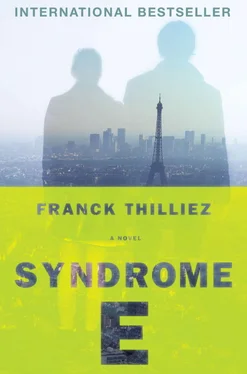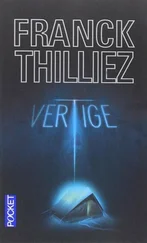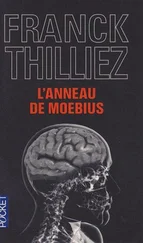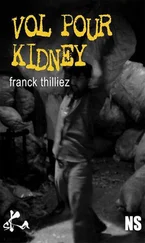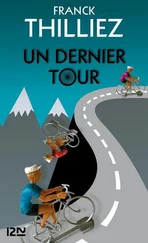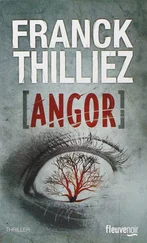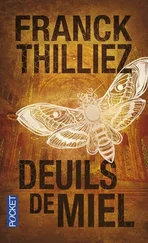Lucie thought of the various close-ups of the girl on the swing, of her face, during the film’s short duration. The blinking eye, the movements of the iris. That feeling of incursion, voyeurism, behind an oval-shaped mask: the eye that takes in light and silently observes… And, especially, of that eyeball sliced in half, the first sequence of the film. She remembered turning away, proof that her brain had reacted violently, that there had indeed been interpretation.
At that point, her vision of the film changed. The director might have included that first brutal scene not as a pure display of horror, but to make a statement: “Concentrate, look carefully at what I’m about to show you.” Or else: “Do as I’ve done with my scalpel—open your eye…”
Open your eye …
In the middle of the night, her cell phone vibrated at the foot of her chair. Lucie did not awake this time; she was much too exhausted.
The text message read: “Claude Poignet here. Come by late tomorrow morning. Some peculiar things about your film, to say the least.”
The two Rouen medical examiners and the forensic anthropologist had spent all day and all night on the case. So their examinations were almost complete when Sharko arrived at the ME’s office the next morning, full of questions. Later, back in Nanterre, he’d probably have to immerse himself in the hundreds of pages of technical data that spewed out of these buildings, so he might as well be as informed as possible and get as many explanations as he could.
Later… He was in no particular hurry to get home, even if it was no great pleasure to wander through this death-haunted complex. Far too many violent incidents and unsolved crimes crowded into his memory. A child found dead at the bottom of the Seine. Prostitutes with their throats cut in seedy hotel rooms. Women and men beaten, lacerated, hacked to pieces, strangled… Dramas that had swept away his life and forced him to run on Zyprexa tablets.
And yet here he was.
Before going to see the medical examiner, he let himself be waylaid by the bone and tooth specialist, Dr. Pierre Plaisant. The physician was about to head off for a lecture on Lowenthal’s caries, which were typical of heroin addicts. The two men exchanged a few banalities before getting down to business.
“The bones had a lot to say for themselves. How should we do this—simple or complicated?”
Plaisant was tall and thin, around thirty. A brilliant brain beneath a high forehead, smooth as a coated pill. Behind him lay radiographs of the bodies, bone joints gnawed at by X-rays.
“Either way. Tell me enough to keep me from having to drag around the fifty pages of tech data that Péresse is going to shove at me.”
The doctor led Sharko to some graduated worktables: stainless steel counters, with sliding rules running crosswise and lengthwise for measuring bones. The four partially reconstituted skeletons each rested on one of them. The room, which looked more like a kitchen than a lab, smelled of dried earth and detergent. The remains had been treated in a bain-marie to remove any soft tissue.
“The fifth cadaver, the best preserved of the lot, is waiting for you in the autopsy room before going into the fridge.”
He picked up a pencil and slid it into the anterior nasal spine of the skeleton on the left, the smallest one.
“The point of the pencil touches the chin. The zygomatics are in front, the face is flat and rounded. No doubt about it, we’ve got an Asiatic. The other four are Caucasian.”
First bit of good news, the presence of an Asian corpse would help them search through the computer database. Plaisant left the pencil in the stiff’s nose, picked up a sliced skull, set it down on its jaws, and pushed it backward. It began to rock.
“You always get this rocking motion with men. Women’s skulls don’t move. Brains are too small—” He smiled. “I’m just kidding…” Sharko’s face remained neutral; he was in no mood for jokes. His sleep had been disturbed by traffic noises and the buzzing of a fly he couldn’t swat. The doctor thought better of his attempt at humor and fell serious again.
“I mainly verified with pelvic bones, which are more reliable. In every ethnicity, the bone that starts at the top of the pubis is taller in women. All our subjects are male.”
“How old?”
“I was getting to that. Since they didn’t have any teeth, I based my findings on the joining of the cranial sutures, arthritic degeneration in the vertebras, and especially the sternal border at the fourth rib. It—”
Sharko suddenly motioned toward the coffeepot.
“Could you pour me some? I didn’t have breakfast this morning, and the odor in this place is making me nauseous.”
His momentum interrupted, Plaisant paused in surprise for a few seconds before walking to the far corner of the lab. He spoke with his back turned.
“We’ve been lucky with our subjects here. The younger they are, the narrower the margin of estimation. After they hit thirty, it gets trickier. To determine ages, we use the pubic symphysis. In a young adult, this part is very rough, with ridges and deep grooves. Then the—”
“How old?”
The coffee was dripping, the coffeemaker gurgling. Plaisant came back toward his skeletons.
“Our men were all between twenty-two and twenty-six at the time of death. As for their height and other anthropometric details, you’ll see all that in the report.”
Chief Inspector Sharko leaned against the wall. All young, all male. That might have been an important criterion, a crucial element for the killer. Was he of their generation? Did he mix with them? In what context? University, sports club? The cop pointed to a half skull that showed a hole near the occiput surrounded by tiny cracks.
“Killed by gunshot?”
The forensic anthropologist picked up a knitting needle.
“Killed or wounded, though for these four it’s most likely killed. The fifth one was probably just wounded in the shoulder—Dr. Busnel will tell you about that.”
With his needle, he pointed to the Asian’s spine.
“This one was shot in the back. His fourth vertebra is shattered from behind. These two were most likely shot and killed from the front. Some ribs are shattered, probably because the bullet ricocheted before finding a vital organ. My colleague in radiography is going to scan them to make a 3-D reconstruction and try to reproduce the entrance and exit points of the projectiles. But it won’t be easy, given their condition. As for the last one… shot right in the head. The bullet didn’t even come out the front.”
He poured coffee into two cups and held one out to Sharko, who stared at the bodies without moving. There was no consistency in the way the men had been eliminated. From behind, from the front, in the head. No ritual: the killings looked scattered, random, whereas the concealment and dehumanization of the bodies displayed great mastery. What could this have been about? An execution? Revenge? Some kind of run-in?
Sharko took a sip of his java.
“I don’t suppose you found any bullets?”
“No. Neither in the organisms nor at the scene. They were all recuperated—sometimes rather brutally. You can tell from the way the ribs were yanked apart on one of the skeletons.”
Sharko had more or less expected the answer. The killer had given every indication of remarkable follow-through, covering all his tracks. No chance of going through ballistics and following the trail back to the murder weapon.
“Any projectile fragments at all?”
Uncoated bullets always left fragments, traces like comets’ tails or snowstorms.
“Not a thing. Definitely jacketed bullets.”
That in itself wasn’t really news to Sharko. Most classic munitions were solid alloys, not hollow lead like for certain hunting rifles. The inspector ran a hand over his hair. He wanted something else, a way of following a serious, physical path. Then he remembered that he was there just as an observer. To get a sense of the killer’s psychology and motivations, nothing more. He wouldn’t give in to the demons of fieldwork.
Читать дальше
